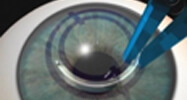Corneal Cross-linking
Corneal collagen cross-linking is a relatively pain-free procedure that is performed to slow or stop the progression of keratoconus. It uses special eye drops called riboflavin and an advanced form of UV light to strengthen your cornea.
Is Cross-linking a cure for Keratoconus or Ectasia?
Currently, there is not a cure for keratoconus or ectasia. Cross-linking slows or halts the progression of the disease to prevent the cornea from becoming more irregular. Often, a patient will utilize various options for improving vision after cross-linking, such as contact lenses or implanted devices known as Intacs®.
Who can have Cross-linking?
- Patients that are deemed good candidates for cross-linking after assessment
- Have been diagnosed with worsening keratoconus or ectasia
- Do not have cornea scarring and do not have corneas that are too thin, steep or flat
- Are not pregnant or breastfeeding
How long does the Cross-linking procedure last?
Based on study results of over a decade, it appears that the strengthening effects may be permanent. In rare situations, the procedure can be repeated if advised by your physician.
How long does the Cross-linking procedure take to perform?
The procedure normally takes 45 minutes and you will be at the treatment center for approximately 2 hours on the day of your procedure.
Is Cross-linking FDA approved?
Yes – crosslinking is an FDA approved procedure in the United States. There are also several IRB-approved studies investigating newer and innovative technology.
Intacs® Corneal Implants
Intacs® Corneal Implants are ophthalmic medical devices designed for the reduction or elimination of myopia and astigmatism in patients with keratoconus so that their functional vision may be restored and the need for a corneal transplant procedure can potentially be deferred. When placed in the corneal stroma, outside of the patient’s central optical zone, the product reduces the conical steepening by flattening the cornea.
The Procedure
Anesthetic drops are used to numb the eye, which is held open throughout the procedure to prevent blinking.
Step 1
A single, small incision is made in the surface of the cornea.

Step 2
The eye is prepared for Intacs® placement.
To stabilize your eye and ensure proper alignment of the Intacs® implants, the centering guide is placed on the surface of your eye. During this time, inner layers of the cornea are gently separated in a narrow circular area to allow for Intacs® placement.

Step 3
The implants are gently placed.
After that, the small opening in the cornea is closed.

Step 4
The procedure is completed. The placement of Intacs® implants reshape and reinforce your cornea, eliminating some or all of the irregularities caused by keratoconus in order to provide you with improved vision.




